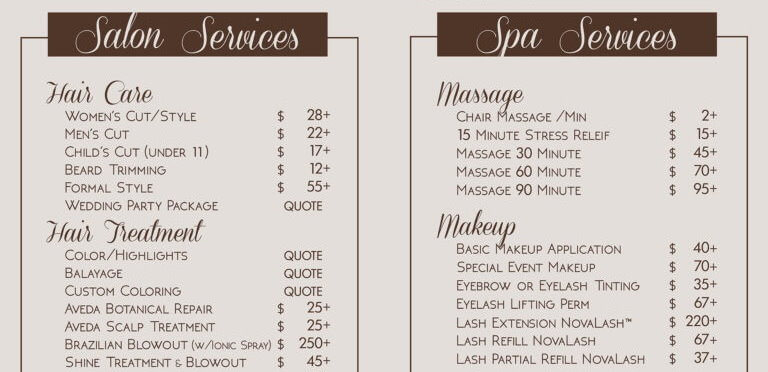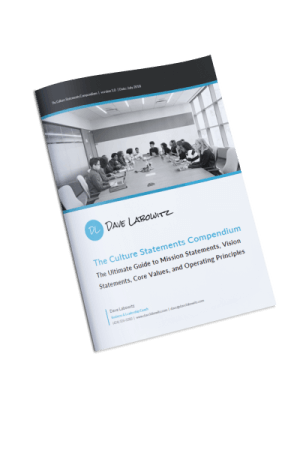If you’re a service business without a menu of services, creating one offers a host of benefits that touch every aspect of your business. A menu of services can help you close more sales, maintain a higher margin, and streamline operations all at the same time. The creation process can be educational, too, in that it forces you to look at your services in an organized manner.
The image above is an example of a simple menu of services for a salon and spa. A menu of professional services may be a bit more complex because your offerings are more involved than “haircut” or “chair massage”, but the goal is the same. You need to productize your services.
What it means to productize your services
Productizing your services means packaging them in a way that they can be easily described, understood, and sold the same way, each time. For example, an estate planning attorney who does wills for clients could sell their service hourly, or they could productize the “Create a Will” service. At the most bare-bones level, it might look something like this:
Create a Will ($600) – Includes 15-minute kick-off meeting, assets and beneficiaries worksheet, one draft revision over email, and permanent document retention
From there, the attorney could wrap some more marketing jargon around the service, explaining why it is better than doing it on your own and answering any other frequently asked questions. Once complete, the productized service, “Create a Will” answers the question, “what do I get if I purchase this service?”
Selling without a menu of services
If you haven’t yet created a menu of services you’re probably selling one of two ways: hourly or by quoting custom jobs. Neither of these is an optimal solution.
When you sell hourly it’s difficult to build in profit margin. Many people fall into the trap of accepting extremely low to zero margin on their time or feeling forced to inflate the hours on their invoices to create some profit. Additionally, many clients are biased against hourly engagements because they prevent budget certainty since the number of hours on a project can vary.
Taking the time to quote a custom job gives you more opportunity to create profit margin through value-based pricing, but the key word is “time.” It’s tremendously time-consuming to create a custom quote for each sales prospect. At one of my past companies that was around $5 million in annual revenue, we had two full-time employees working on nothing but proposals!
This may make sense for some businesses if you’re dealing with very complex, high-dollar contracts, but for most people, it just becomes a time suck. The time it takes you to generate a custom quote doesn’t just eat your schedule, it slows down your sales cycle. And, since each quote is highly customized, you’re introducing the risk of poorly communicated expectations which can cause problems later.
The benefits of using a menu of services
In contrast, look at the benefits of selling with a menu of services:
You can be strategic about margin
Since you’re doing most of the work building your menu of services only once, you can invest more time ensuring that each service you offer has a comfortable amount of margin built into it. Leverage a value-based pricing approach. If you offer services that have an inherently lower margin than others, you can package them with higher-margin services on your menu so they don’t have to be sold on their own.
You save time on writing proposals
No more custom proposals and intricate quotes! The only thing you’ll need to customize is the email to which you attach your menu of services.
A menu of services reduces ambiguity
The description of each service on your menu will reduce customer confusion and help set accurate expectations. Additionally, you can use your menu of services as a starting point for building more comprehensive documentation for project management. Going back to our “Create a Will” example, you can build a project guideline that identifies deliverables, milestones, and vendor/client responsibilities. You may not want to include all this detail right on your menu of services; you can supply it as an exhibit in a contract or as a kickoff meeting deliverable.
Create a Will ($600) –
- 15-minute kick-off meeting
- Attorney supplies assets and beneficiaries worksheet
- Client creates a list of assets and beneficiaries
- Attorney drafts contract
- Client redlines draft (one revision allowed)
- Attorney sends final draft
- Client sends executed and notarized will to attorney
- Attorney maintains a copy of will indefinitely
Your pricing can guide prospects
If you offer different levels of service (think of a Silver, Gold, and Platinum package), you can set your pricing in such a way that it naturally guides many clients to pick the package you most prefer to sell. This is common in SaaS software productization. The software industry knows prospects most commonly pick the middle-tier option, so they make sure that one has the best margin for them.
Menu of service add-ons offer a tailored solution
While you’re no longer building custom proposals, you can include different add-ons and options on your menu of services that allow prospects to build a solution tailored for them. For example, not everyone who needs a will needs to create an Advanced Directive, Living Will, and Power of Attorney, but many do. These services could be offered as add-ons to the “Create a Will” service for $100 each.
Some tips on creating your menu of services
If you’ve decided to dive in and create a productized menu of services, great! Here are a few tips on what to do.
Make a list of everything you do
Start by making a comprehensive list of everything you do for clients, whether or not you think of it as something you sell or something that’s “included.” For example, in the “Create a Will” service, you wouldn’t sell “provide an assets and beneficiaries worksheet” separately. But it belongs on the list because you’ll want to itemize it somewhere because it’s part of the value you provide. Itemizing these “included” parts of the service helps validate your value-based pricing.
Package things together
Once you have your full list of service line items, you’ll want to start packaging them together into saleable services. It may help to consider each of your key service offerings from that Silver, Gold, Platinum approach. Silver is a cut-rate package for price-sensitive prospects, Gold is your “ideal” package with a solid service offering at a good margin, and Platinum is your Rolls Royce package for prospects who want everything you offer.
Add-ons can be included with higher-level service offerings or sold separately for any service offering. For example, “Create a Will – Platinum” might include Advance Directive, Living Will, and Power of Attorney documents at a discount to what they would cost if they were sold individually.
Identify and productize variables that impact your cost
You may come across some services that are difficult to standardize because they have some sort of variable that impacts your cost of service delivery (and value to the client). For example, if you’re a boutique marketing firm, your content editing service is the same for all clients but the number of words you’re editing can vary wildly. You’d never dream of charging the same for a 300-word social post as you would for a 2,000-word blog article. In cases like this you have a few options:
- Charge hourly: content editing is $40 per hour
- Charge based on volume: $20 for 300 words or less, $20 for each additional 200 words. This is my personal favorite.
- Offer a tiered option: $20 for less than 300 words, $50 for 300-1,000 words, and $80 for 1,000 words and up. The risk here is that someone sends you 5,000 words and you’re stuck doing it for $80.
Now that you’ve created your menu of services, use it! You can post it on your website and/or send it to prospective customers upon request. It’s up to you if you publicize pricing or only send pricing to prospects who request it.






